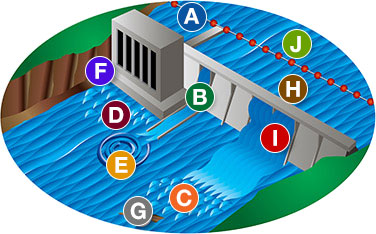Injuries and even death occur each year at dams across the nation. You can avoid accidents by staying clear of restricted zones, understanding dangers and obeying all warning devices near dams.
Safety tips
- Always stay a safe distance outside of warning signs, buoys and barriers when fishing, boating or swimming.
- Stay away from the edge of waters above and below hydroelectric stations.
- Be sure to obey all warning signs and signals.
- Stay back from dry riverbeds below dams. They can quickly change into rapidly flowing waterways.
Warning signs of rising water:
- Flashing lights, horns, or sirens.
- Increased or changed wildlife activity.
- Louder sound of rushing water.
- Previously exposed rocks or snags are covered with water.
- Clear water quickly becomes cloudy.
- Suddenly faster water currents.
Critical danger zones at dams

- Hazard area marked by buoy lines
- Sudden water discharge from dam gates
- Strong, unpredictable currents above and below dams
- Sudden turbulent discharges from automatically operated power house generators
- Deceiving reverse currents below spillways
- Slippery surfaces on dam structures and shorelines
- Submerged hazards above and below dams
- Open spillways which may not be visible from above the dam
- Debris passing over or through the dam
- Ice that forms near a dam is often thin and unsafe
Boating tips
(applies to boats, canoes, kayaks and other watercraft.)
- Never anchor a boat below a dam because rapid water level surges can pull an anchored boat under water in seconds.
- Beware of dangerous and unseen currents. Backrollers, eddys, and whirlpools can pull a boat upstream into a spillway and quickly capsize it.
- Always maintain a safe distance if above or below a dam. If your boat has a motor, keep it running to be able to leave area quickly.
- Stay away from spillways. Changing currents and unpredictable waves make boat control difficult.